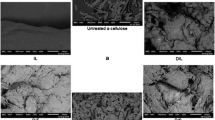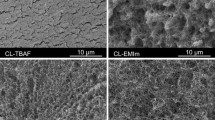Abstract
A TG–MS analysis was applied to reveal the reproducibility of preparation of cellulose-based cryogels. The cellulose materials were obtained by dissolution of cellulose in melted Ca(SCN)2, followed by gelation and regeneration in an ethanol bath and dried by lyophilisation. The whole preparation process was repeated 14 times. The pyrolysis of the prepared samples was investigated by TG–MS. A number of parameters were determined from the obtained TG, DSC and MS curves and statistically analysed. TG and MS data together with estimated reactions which occurred during sample decomposition enable the calculation of the composition of cryogels and pyrolysed material. An unexpected amount of calcium thiocyanate was found in cellulose cryogels (about 31 %) and after pyrolysis, a high content of calcium oxide (about 58 %) as a product of calcium thiocyanate decomposition was calculated for the final material. The total yield of carbon from cellulose decomposition was about 12 %. From the obtained data, it could be concluded that the preparation of cellulose cryogels is well reproducible if the amounts of the initial substances are kept constant.







Similar content being viewed by others
References
Hoepfner S, Ratke L, Milow B. Synthesis and characterisation of nanofibrillar cellulose aerogels. Cellulose. 2008;15:121–9.
Surapolchai W, Schiraldi D. A. The effects of physical and chemical interactions in the formation of cellulose aerogels. Polym Bull. 2010;65:951–60.
Deng M, Zhou Q, Du A, van Kasteren J, Wang Y. Preparation of nanoporous cellulose foams from cellulose-ionic liquid solutions. Mater Lett. 2009;63:1851–4.
Hüsing N, Schubert U. Aerogels-Airy materials: chemistry, structure, and properties. Angew Chem Int Edit. 1998;37:22–45.
Fischer F, Rigacci A, Pirard R, Berthon-Fabry S, Achard P. Cellulose-based aerogels. Polymer. 2006;47(7636–764):5.
Aaltonen O, Jauhiainen O. The preparation of lignocellulosic aerogels from ionic liquid solutions. Carbohyd Polym. 2009;75:125–9.
Innerlohinger J, Weber HK, Kraft G. Aerocellulose: Aerogels and aerogel-like materials made from cellulose. Macromol Symp. 2006;244:126–35.
Cai J, Kimura S, Wada M, Kuga S, Zhang L. Cellulose aerogels from aqueous alkali hydroxide–urea solution. ChemSusChem. 2008;1:149–54.
Isobe N, Kim U-J, Kimura S, Wada M, Kuga S. Internal surface polarity of regenerated cellulose gel depends on the species used as coagulant. J Colloid Interface Sci. 2011;359:194–201.
Grzyb B, Hildenbrand C, Berthon-Fabry S, Bégin D, Job N, Rigacci A, Achard P. Functionalisation and chemical characterisation of cellulose-derived carbon aerogels. Carbon. 2010;48:2297–307.
Jin H, Nishiyama Y, Wada M, Kuga S. Nanofibrillar cellulose aerogels. Colloid Surf A. 2004;240(63–6):7.
Duchemin BJC, Staiger MP, Tucker N, Newman RH. Aerocellulose based on all-cellulose composites. J Appl Polym Sci. 2010;115:216–21.
Luong ND, Lee Y, Nam J. Highly-loaded silver nanoparticles in ultrafine cellulose acetate nanofibrillar aerogel. Eur Polym J. 2008;44:3116–21.
Sescousse R, Gavillon R, Budtova T. Aerocellulose from cellulose-ionic liquid solutions: preparation, properties and comparison with cellulose-NaOH and cellulose-NMMO routes. Carbohyd Polym. 2011;83:1766–74.
Štefelová J. Carbonaceous materials based on saccharides. Diploma thesis. University of Ostrava, Faculty of Science, 2012 (in Czech).
Pappa A, Mikedi K, Tzamtzis N, Statheropoulos M. Chemometric methods for studying the effects of chemicals on cellulose pyrolysis by thermogravimetry–mass spectrometry. J Anal Appl Pyrol. 2003;67:221–35.
NIST/EPA/NIH Mass Spectral Library with NIST Mass Spectral Search Program (Software version 2.0), 2001.
Horn PS. Some easy t statistics. J Am Stat Assoc. 1983;78:930–6.
Meloun M, Hill M, Militký J, Kupka K. Analysis of large and small samples of biochemical and clinical data. Clin Chem Lab Med. 2001;39(1):53–61.
Khelfa A, Finqueneisel G, Auber M, Weber JV. Influence of some minerals on the cellulose thermal degradation mechanisms. Thermogravimetric and pyrolysis-mass spectrometry studies. J Therm Anal Calorim. 2008;92;795–799.
Dong Ch, Zhang Z, Lu Q, Yang Y. Characteristics and mechanism study of analytical fast pyrolysis of poplar wood. Energ Convers Manage. 2012;57:49–59.
Shen D, Ye J, Xiao R, Zhang H. TG-MS analysis for thermal decomposition of cellulose under different atmospheres. Carbohyd Polym. 2013;98:514–21.
Herawan SG, Hadi MS, Ayob MR, Putra A. Characterization of activated carbons from oil-palm shell by CO2 activation with no holding carbonization temperature. Sci World J. 2013. doi:10.1155/2013/624865. Accepted 15 April 2013.
Małecki A. Temperature, heat, mass: the development of measurement methods. Lecture on the CCTA 11: 11th Conference on Calorimetry and Thermal Analysis, Zakopane, 9–13 Sept, 2012.
Lin YC, Cho J, Tompsett GA, Westmoreland PR, Huber GW. Kinetics and mechanism of cellulose pyrolysis. J Phys Chem C. 2009;113:20097–107.
Acknowledgements
This work was financially supported by the Ministry of Education, Youth and Sports of the Czech Republic in the “National Feasibility Program I”, project LO1208 “Theoretical Aspects of Energetic Treatment of Waste and Environment Protection against Negative Impacts” and by a project of the Moravia-Silesian region, reg. No. 02508/2013/RRC. The University of Ostrava supported this research by means of SGS reg. No. SGS03/PřF/2014.
Author information
Authors and Affiliations
Corresponding author
Rights and permissions
About this article
Cite this article
Štefelová, J., Slovák, V. Reproducibility of preparation of cellulose-based cryogels characterised by TG–MS. J Therm Anal Calorim 119, 359–367 (2015). https://doi.org/10.1007/s10973-014-4158-8
Received:
Accepted:
Published:
Issue Date:
DOI: https://doi.org/10.1007/s10973-014-4158-8




